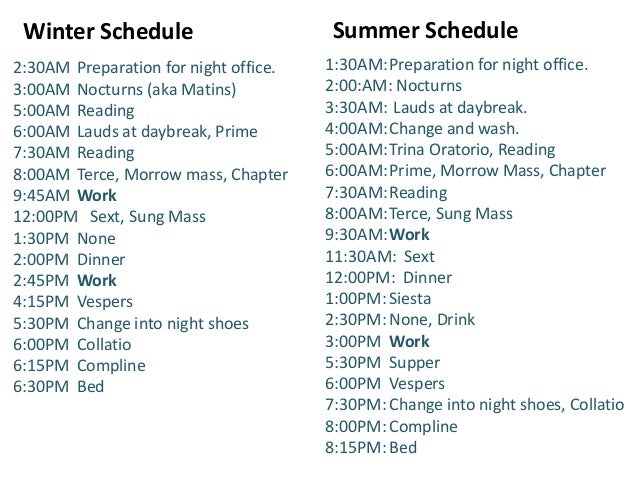 |
| Baroque choir bench end in church at Friedrichshafen, Germany |
I guess we often picture monks chanting away in Latin or praying all day..Certainly this was how they would spend much of their day. It has been called Opus Dei (work of God) or Liturgia Horarium (Liturgy of the Hours).It is about the fixed canonical hours when they came together to pray in word and song. In this post I will consider their whole daily sequence.
Perhaps the hardest part to grasp is the concept of hours whch vary in length according to the season! We have already looked at this in earlier posts but we have to come back to it again. If we consider there were 12 hour nights and 12 hour days the summer hours were longer (because it was light longer) and the winter days shorter (because it was dark longer). Winter hours started about 13 September and lasted until the start of Lent : Ash Wednesday. Summer hours therefore from the start of Lent until mid September. Another way of looking at it is to say that winter "hours" were 10 minutes shorter than summer "hours" or that summer "hours" were 10 minutes longer than winter "hours".
The pattern of prayer in canonical hours remained the same throughout the year with the same offices or services. The length of these and the content each day depended on whether it was an ordinary day or whether it was Sunday or special in the eyes of the Church so that modifications should be made. This was most often because it was a Church feast day, and there were lots of these. We think of Christmas, Easter, Pentecost for example. But there were over 100 Saints' days as well as the major feasts. Together with all Sundays = 150 days a year or 3 days a week. This is important!
In addition the pattern would be affected by times of penitence when prayer would be extended, visitations, hospitality, involvement in secular affairs, dealing with the poor, stocktaking and administration. This meant that not all monks would be at all of the offices.In addition when we start investigating individual monasteries we find evidence of constant rebuilding and the likely consequences in day to day life! (Remember what it was like when you had your kitchen redone....)
 |
| Baroque choir stalls and Baroque organ from later centuries |
The schedule of eight offices which is quoted as the norm evolved before the 6th century. Office means a service where monks come together to worship to a specified format. All this was specified in the Rule of St Benedict although not really a Benedictine invention. By the end of the 7th century High Mass was added to the schedule of eight offices and a lesser Mass from the 10th century.
The pattern established in the Benedictine Rule became the foundation of most monastic timetables of all the monastic orders theoughout the following centuries.The length and time varied but the structure would remain the same in 1500 as in 1200. There would be changes due to abbreviations and extra psalms and prayers. There would be some differences in timing and length due to climate and according to the practice of different Orders of monks.
A good introduction is the BBC "Day in the life of a Benedictine Monk". Watch it here.
Here is the general pattern :
First there was the NIGHT OFFICE or service held in what we might call the middle of the night. This seems to me the most extreme of all. In researching this I detect that the timimg was changed sometimes due to the season. Length would vary according to the seriousness of the day: which means holy days would have longer celebrations.I do not think we can be sure that these night celebrations always took place as specified. When monastic communities got slacker in their observances it is possible that this is where they slipped down. However I am starting start with the ideal.
MATINS this is the Night Office. Sometimes called NOCTURNS.The Benedictine Rule sais it should be the 8th hour of the night. This could make it 2.00 am.....in summer it was likely moved back to midnight. It could be a avwry long service on a holy day. Perhaps 2 hours.
LAUDS Sometimes this was sung immediately after MATINS. Otherwise it would be before daybreak.Shorter perhaps 45 miniutes.
PRIME supposed to be sung at Dawn. 30-45 minutes.
TERCE shorter office - about 30 minutes
(Light breakfast sometimes)
Chapter meeting
SEXT shorter office - about 30 minutes
HIGH MASS important and lasted about 60 minutes
(Dinner)
NONES shorter office -about 30 minutes
VESPERS longer office - 60 minutes
(Supper sometimes)
COMPLINE to finish the day - perhaps 30 minutes
I have been considering how to make all this simple and how much detail to include. It is impssible to reconcile all the patterns of worship (Honoraria) by monastic communities that I have discovered! To try to do this would be hedged in qualifications (different Orders, places, times, holy day or ordinary day) so I am going to leave it at that for the moment with the addition of the stuff below.
I shall return in later posts about what the offiices included, how they kept awake (or didnt), chanting, how cold it must have been etc etc.


